Linguist Collaborates To Preserve Plant Knowledge and Customs in Papua New Guinea
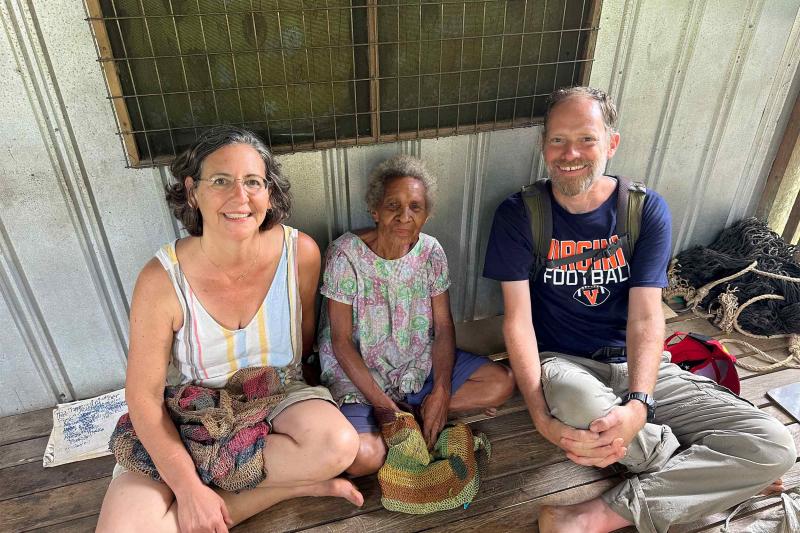
If a spoken language has few who can understand it, does useful cultural knowledge get lost?
As a scholar of Papua New Guinea’s endangered Arapesh languages, University of Virginia anthropology and linguistics professor Lise Dobrin can say with certainty, “yes.”
She is interested in helping to document some of the know-how about the natural environment there.
Dobrin led a pre-opening walk-through of a new exhibit at the Fralin Museum of Art, featuring the Southwestern Pacific island’s intricate “garamut” drums. The exhibit runs through June 2. The drums are wholly carved from individual trees, and the one at the center of the room is mammoth.
“This exhibit is an exercise in public anthropology,” Dobrin said. “For me, the challenge was, ‘How do I take 20 years of experience learning from these people about their language and culture and reduce it to 200 words on the wall that somebody can read and learn from?’”
Dobrin recently collaborated with villagers and UVA community members not just for the museum exhibit, but also as part of a summer research trip to document the Arapesh culture’s waning tree and plant knowledge.
Making a Felled Tree Speak
The drums are called garamuts after the name of a tree species on the island. They’re also known as “slit drums” because they have a slit carved in them. They’re crafted from single felled trees – the kind being logged on the island these days by outsiders – and are able to communicate messages across great distances.
Drum making is a group effort. Craftsmen hollow the tree out and try its sound until they hear that it “speaks.” Next come intricate carvings – birds, crocodiles and other animal-inspired designs – and the paint. Finally, they present the drum to the village and celebrate.
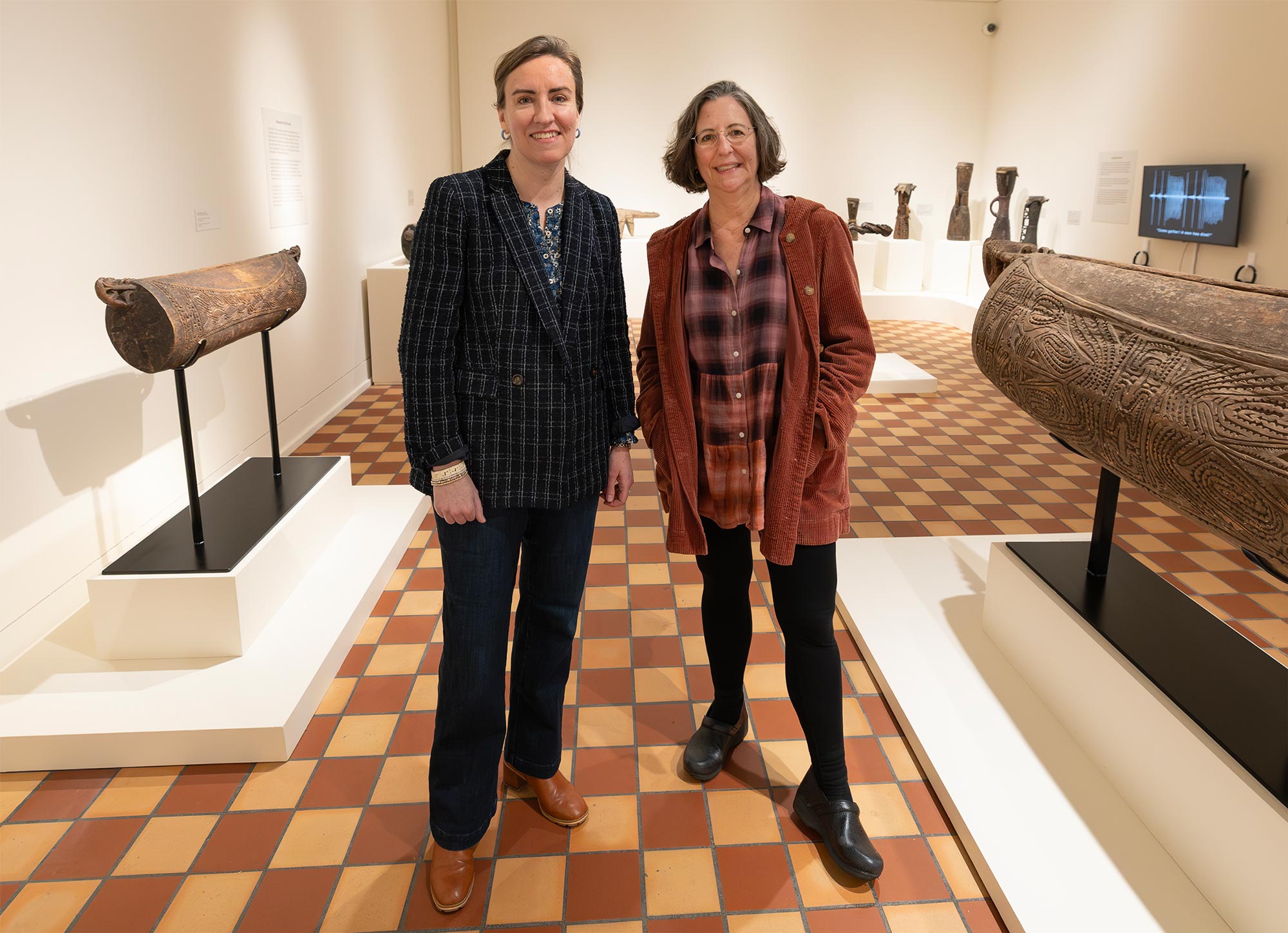
Academic curator M. Jordan Love and professor Lise Dobrin are co-curators of a new exhibit at The Fralin Museum of Art. The exhibit primarily features slit drums from Papua New Guinea. Andrew Moutu, a Papua New Guinean anthropologist, also contributed to the exhibit. (Photo by Matt Riley, University Communications)
Andrew Moutu, a Papua New Guinean anthropologist, was a consultant on The Fralin’s exhibit. Dobrin began collaborating with him after she was adopted by his village, Wautogik, some 25 years ago, making Moutu both a kinsman and a colleague. He is the former director of the National Museum & Art Gallery in Papua New Guinea, having earned a doctorate in anthropology from University of Cambridge.
As part of the exhibit, Dobrin presents audio that captures a villager beating the messages with varying degrees of cadence and urgency.
“Come gather!” he drums (quietly, so as not to create a false alarm). “A man has died.”
Students who took Dobrin’s course Curating Culture last spring got to interview Moutu about the drums and their meaning as they learned how to handle a culture’s material items with knowledge and respect. Short segments from their hourlong interview are also part of the exhibit.
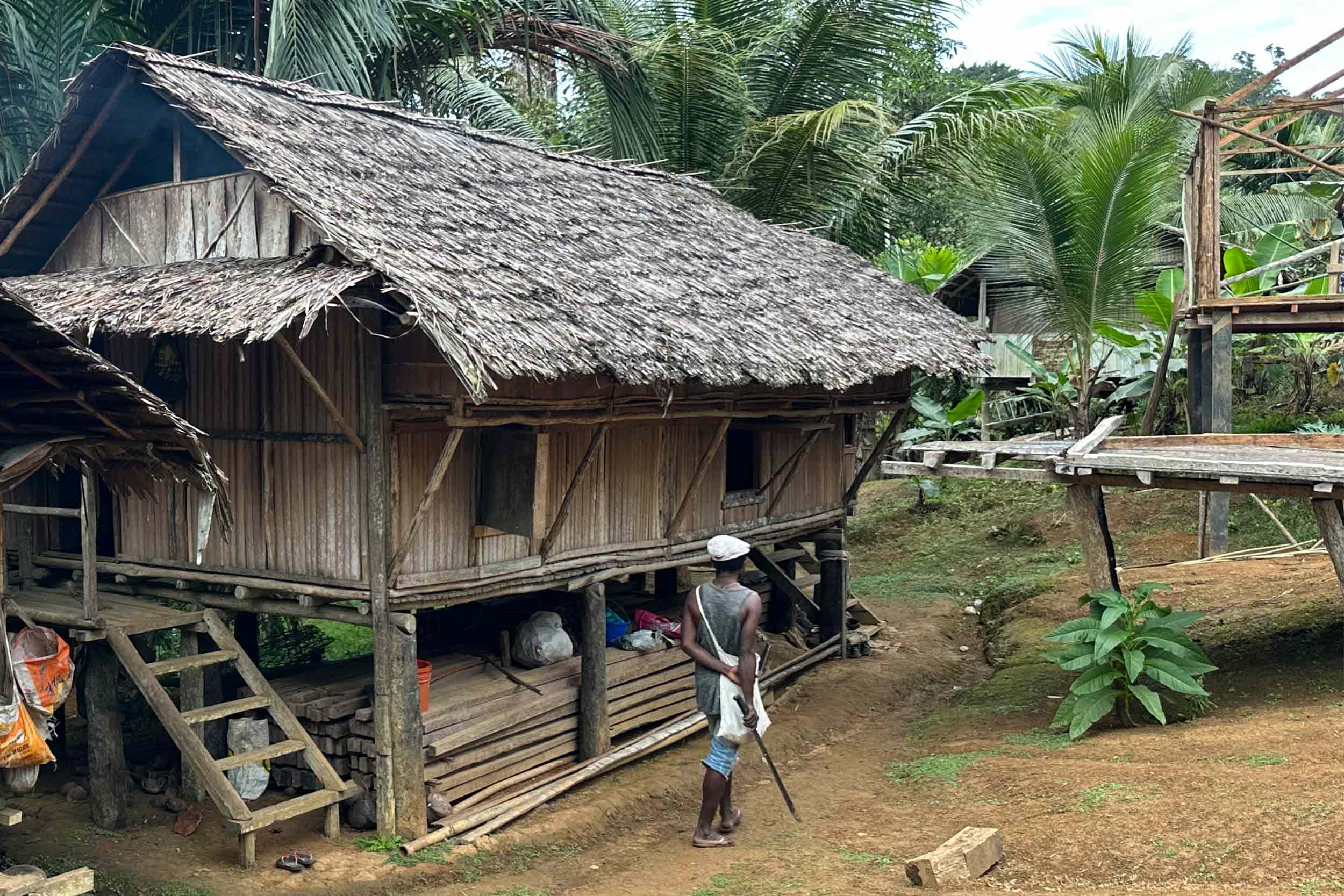
Pais Wochem, who worked closely with Dobrin and Huish on the banana research, walks in his home village of Wautogik. (Photo by Ryan Huish)
New Guinea is the second-largest island in the world, located just north of Australia. The sprawling land mass is home to 15 million people, though it’s split into two different political territories. To the west is Indonesia. To the east is Papua New Guinea.
Arapesh is one of about 850 native languages or language groups on the island. Cemaun Arapesh, spoken in Wautogik, is one of numerous variations of the tongue.
“They traditionally wanted to have a lot of different languages,” the professor explained. “I could speak four languages and you would know who my allies were. In a way, the person who had more languages was a person of greater stature.”
New Guinea has always prized such novelty and cultural exchange, Dobrin said. But now, fluent Cemaun Arapesh speakers are down to just a handful.
Documenting Declining Knowledge
When Dobrin originally ventured to New Guinea as a University of Chicago doctoral student, she was there to study the language’s “fascinating” system for classifying nouns.
“I was getting lots of names of things,” she said. “And I realized that I’m making a dictionary, but I don’t know what many things in this dictionary are, like, this type of tree or that type of tree. And so it was getting to feel kind of irresponsible.”
Villagers, ironically, are having the same problem.
“Elders say that they can no longer send young men out into the rainforest to cut trees for house posts and expect them to bring back the right species,” she said.
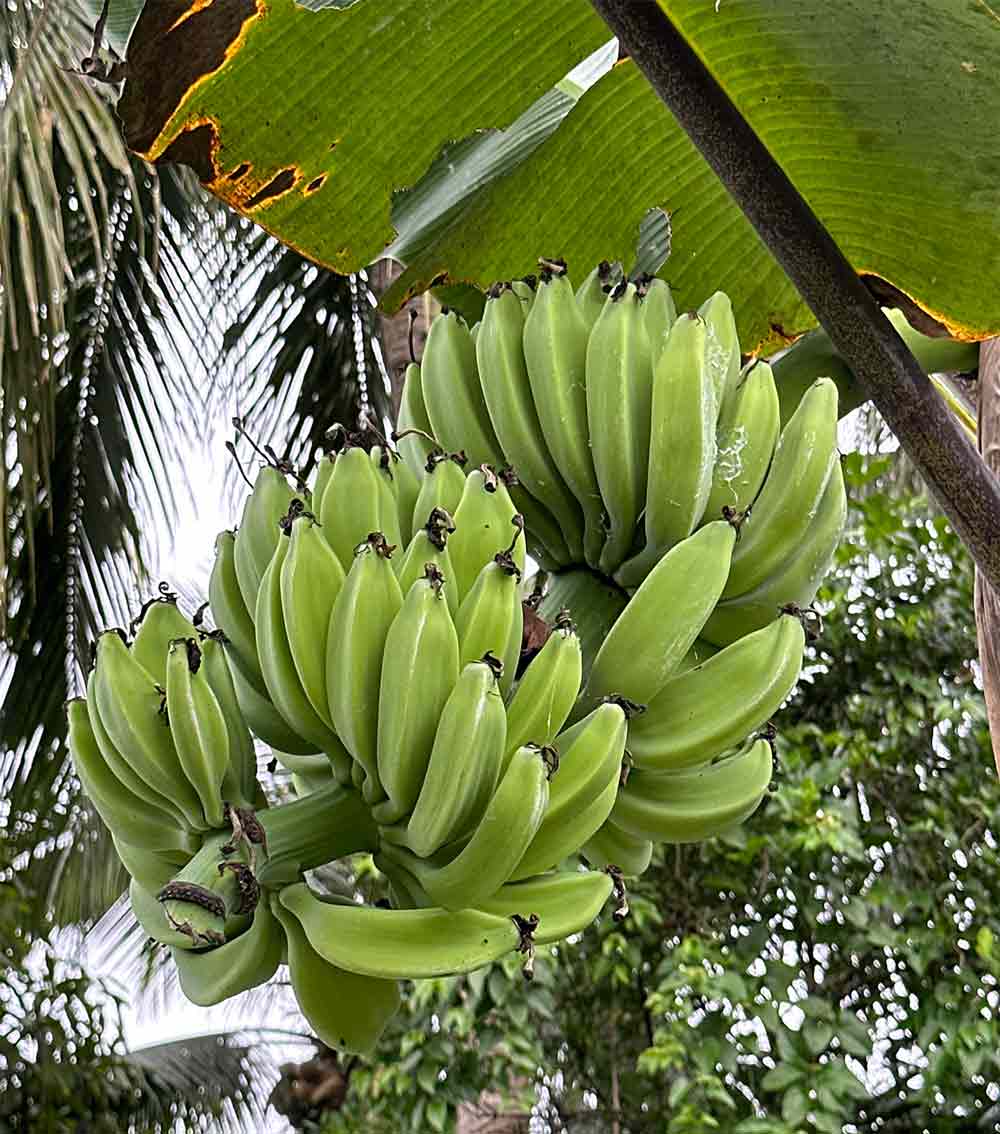
Most of the world eats only the Cavendish variety of banana, which is endangered due to a prolific fungus. Papua New Guinea’s traditional knowledge and more than 1,000 native banana varieties may become useful in the search for a replacement. Pictured is the kalapua variety. (Photo by Ryan Huish)
Dobrin partnered on her summer fieldwork, funded by the UVA Environmental Institute, with UVA Wise ethnobotanist Ryan Huish, an associate professor of biology whose previous fieldwork has stretched from Appalachia to the kingdom of Tonga in Polynesia.
New Guinea is one of the most biodiverse locations on Earth. For Huish, the opportunity was too good to pass up.
“The people are so ingenious, and even though they’re on the other side of the world in a different biome than we are, their biocultural wisdom can be applied in so many ways,” he said.
Once their travel was approved, Dobrin called upon her network at Wautogik and formed groups led by elders to take them through the lush landscape.
Huish asked questions. Dobrin translated. Together, they documented several hundred plant species.
“Pretty good for about a month,” Dobrin said.
Their efforts included specimen collection. UVA Wise has an herbarium that will house dried cuttings and digitized images from the research. The work was done in conjunction with Papua New Guinea’s national herbarium and under the guidelines of the United Nation’s Convention on Biological Diversity’s Nagoya Protocol. The international agreement is aimed at making sure genetic resources are shared in a fair and equitable way.
Of all the flora, Huish was particularly interested in bananas. The world’s most popular variety, Cavendish, is threatened due to the monoculture’s susceptibility to an aggressive fungus called Fusarium wilt. One day, Papua New Guinea’s traditional knowledge and more than 1,000 native varieties may help address this problem.
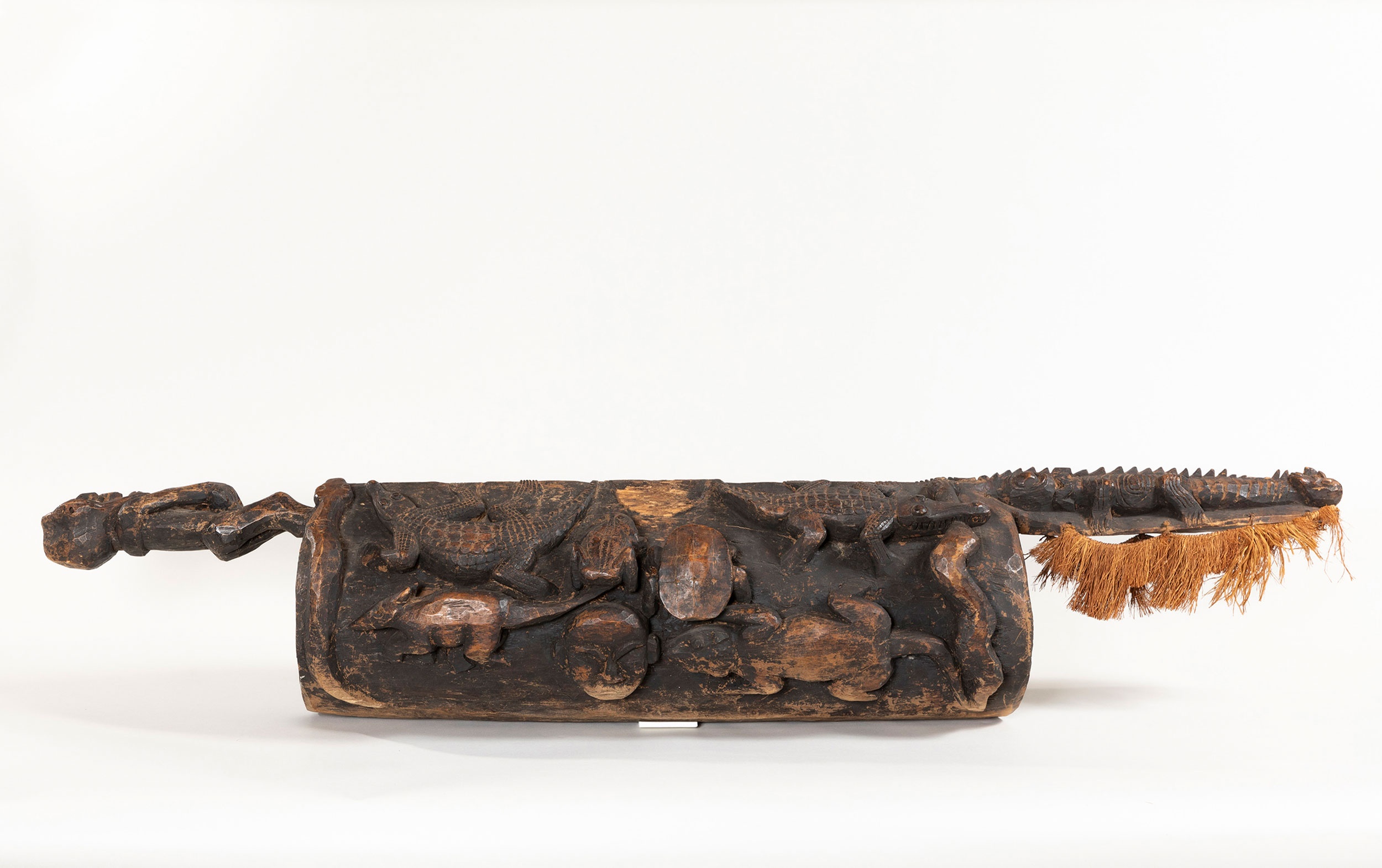
Images of two mythic crocodiles adorn the top of this slit drum, created by an artist from either the Iatmul tribe or the Chambri people. One represents creation, the other death and destruction. The sides also feature a human figure and well-known ancestral animals, each associated with a clan, including the wallaby, rat, snake, frog, bird, and turtle. The piece was a gift from benefactor Daniel Melnick. (Image courtesy of The Fralin Museum of Art)
“They had dozens of types of bananas just within their village and agroforestry plots alone,” Huish said. “I remember hearing them separating them from ‘imported’ ones they had there, too. I originally thought these were imported from other countries, but soon found out that they were referring to different varieties brought in from different villages within Papua New Guinea. It was an indication that the diversity of bananas across the country is so much more expansive than we previously thought, and that the varieties within their village were possibly even new to science.”
But the researchers said it appears that some banana cultivars are being lost due to unintentional neglect.
“With so much importation going on, there’s a lot of allowing old varieties to fade away,” Dobrin said. “This is very comparable to the language situation.”
Nothing Lasts Forever
The transient nature of the Arapesh culture may be embodied best in the slit drums, though.
Dobrin’s other co-curator on the exhibit is M. Jordan Love, who serves as the Carol R. Angle academic curator. Love’s father was also a prolific collector of New Guinea drums and other art, she said.
As Dobrin worked on the exhibit’s finishing touches, Love stood beside the big drum, made available by Washington and Lee University. Love said that it’s an honor to be able to add the drum to the Fralin’s collection and to share all the cultural artifacts with the public.
“Western culture typically associates drums with music, and we’re hoping to broaden visitors’ perspectives on this idea that drums are message carriers,” Love said. “While slit drums are musical instruments, they are also able to ‘speak’ to others who are far away.”
The researchers said preservation is important, but villagers understand there is also some grace in letting things go their natural way.
We’re here to answer your questions! Contact us today.







